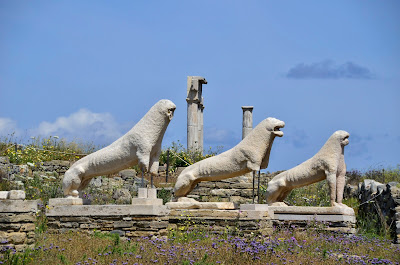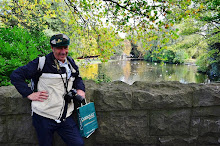Delos - A slave to history
Delos,
I’d never heard of the place. It’s a
small island just half an hour ferry ride from Mykonos and it first cropped up
when I was researching Mykonos. I’d
bought a Greek Islands travel guide and Delos had two whole pages devoted to
it.
When we arrived at Mykonos our hotel loaned us a book and Delos had 33 pages dedicated to it. I determined it was my one “must see” while staying at Mykonos. Getting there was a laugh; the 9.15 ferry had been altered to 10.00 and they said they would return at 1.00 or 1.30. Lorraine, acutely aware of the time factor occurring due to our later exit to Santorini, pleaded with them for 1.00 or we wouldn’t travel. They instantly decreed a 1.00 return; so much for timetables.
When we arrived at Mykonos our hotel loaned us a book and Delos had 33 pages dedicated to it. I determined it was my one “must see” while staying at Mykonos. Getting there was a laugh; the 9.15 ferry had been altered to 10.00 and they said they would return at 1.00 or 1.30. Lorraine, acutely aware of the time factor occurring due to our later exit to Santorini, pleaded with them for 1.00 or we wouldn’t travel. They instantly decreed a 1.00 return; so much for timetables.
We eased
from the harbour and into the morning wind, passing by Agh. Gerogios Island and
soon after arriving at the fabled place named Delos. At first view it seems extraordinary that
25,000 people (our guide said 30,000) lived here at one time. This tiny windswept speck of just 6.85 square
kms in the Aegean Sea has a history, and what a history it is.


| Some of the wonder of Delos |
 |
| Poseidonites Temple |
Still,
standing on the island today imagining a multitude of ships plying trade back
and forth almost beggars belief. Though
protected, the port is small and they must have berthed one on top of the
other, as sailing ships were wont to do in the 19th century, yet
this was over 2,500 years ago.
Our guide
showed us shops and houses, explaining sewerage systems (they were flushed with
sea water to conserve drinking water), house construction (no windows to
prevent malaria carrying mosquitoes from the lone swamp), the Italian agora
(market place) and theatre, emphasising how important it was in Hellenic
culture as it was free and troubadours used to travel around the Mediterranean
to various venues. Only males were
allowed to act in plays and mostly males attended.
 |
| Sewer works for the theatre |
 |
| More temple remnants |
The
greatest of the many statues dedicated to Apollo was 9 metres high, sculpted
from a single block of marble weighing 32 tonnes. They built a temple to it where it was
supposed to reside but got the measurements wrong. The statue was too big to fit in and so was
installed outside where it could be seen from the harbour. In 1416 a Florentine attempted to raise it,
to no avail. In 1675 its head was cut
off and has been lost forever, but the torso and pelvis were also dragged away
but for some reason were abandoned and still lie there whilst the Delos Museum
has its left hand and the British Museum a section of the left leg.
There
were a modicum of other things in the museum as well that promoted interest,
most notably the statuary and mosaics; a worthwhile place to spend some time.
 |
| One of the few mosaics in the museum |
From 700
B.C. the place started to flourish and, when later it became a free trade (no
taxes) port from 314 B.C. to 166 B.C., with slaves the number one commodity, it
boomed. Eventually the Athenian league,
in a cleverly disguised ploy to take it over, decreed that the place needed to
be cleansed so all births and deaths had to take place on the neighbouring
island of Rhenia, thus ruling out any hereditary type claims and then Athenians
were implanted here using a ballot system, so popular was the place.
Later,
when under Roman control, around 87 B.C. Mithridates Eupator, who already ruled
all the countries around the Black Sea, looted the place to obtain money to
hire mercenaries. It is estimated that
20,000 people were slaughtered and that caused the demise of Delos.
During
the ensuing centuries people would come and take building materials, leaving
little for today’s tourists to savour, but enough to give a good outline of the
place and cause one to enthuse about what an amazing place it was.
The
Avenue of the Lions, some temples and an area of houses behind the theatre
still contain enough upright walls and columns to give you a general idea of
how thriving Delos was in its heyday, and you can still imagine the agora with
different kingdoms vying for a presence there and erecting ever larger facades
to denote their presence.
 |
| The old harbour at Delos |
Definitely
a place worthy of your time if you’re in the area
Labels: Agh. Gerogios Island, Apollo, Artemis, Delos, Greek Islands, Hera, history, Mykonos, Poseidonites, temples, Zeus




0 Comments:
Post a Comment
<< Home